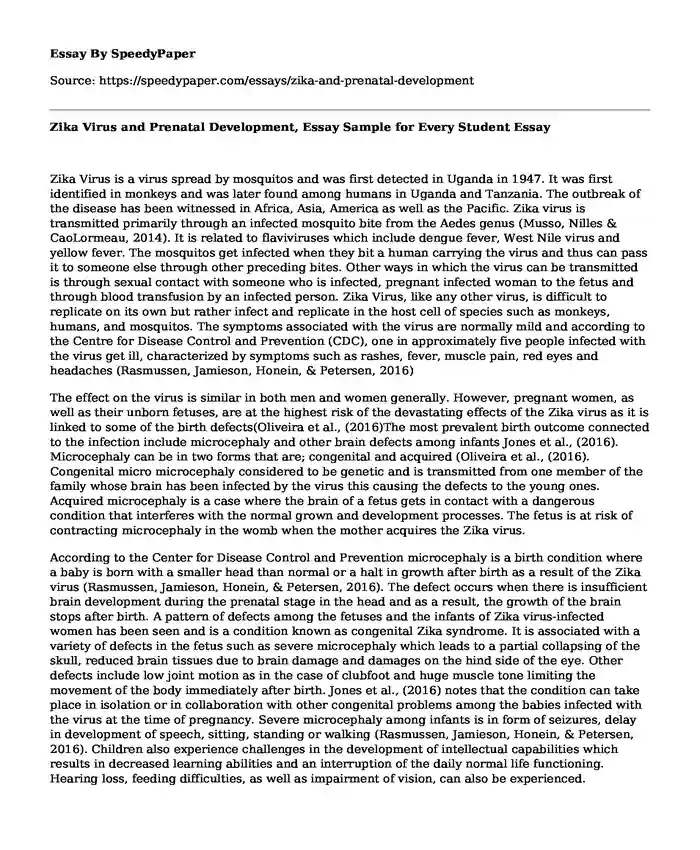Zika Virus is a virus spread by mosquitos and was first detected in Uganda in 1947. It was first identified in monkeys and was later found among humans in Uganda and Tanzania. The outbreak of the disease has been witnessed in Africa, Asia, America as well as the Pacific. Zika virus is transmitted primarily through an infected mosquito bite from the Aedes genus (Musso, Nilles & CaoLormeau, 2014). It is related to flaviviruses which include dengue fever, West Nile virus and yellow fever. The mosquitos get infected when they bit a human carrying the virus and thus can pass it to someone else through other preceding bites. Other ways in which the virus can be transmitted is through sexual contact with someone who is infected, pregnant infected woman to the fetus and through blood transfusion by an infected person. Zika Virus, like any other virus, is difficult to replicate on its own but rather infect and replicate in the host cell of species such as monkeys, humans, and mosquitos. The symptoms associated with the virus are normally mild and according to the Centre for Disease Control and Prevention (CDC), one in approximately five people infected with the virus get ill, characterized by symptoms such as rashes, fever, muscle pain, red eyes and headaches (Rasmussen, Jamieson, Honein, & Petersen, 2016)
The effect on the virus is similar in both men and women generally. However, pregnant women, as well as their unborn fetuses, are at the highest risk of the devastating effects of the Zika virus as it is linked to some of the birth defects(Oliveira et al., (2016)The most prevalent birth outcome connected to the infection include microcephaly and other brain defects among infants Jones et al., (2016). Microcephaly can be in two forms that are; congenital and acquired (Oliveira et al., (2016). Congenital micro microcephaly considered to be genetic and is transmitted from one member of the family whose brain has been infected by the virus this causing the defects to the young ones. Acquired microcephaly is a case where the brain of a fetus gets in contact with a dangerous condition that interferes with the normal grown and development processes. The fetus is at risk of contracting microcephaly in the womb when the mother acquires the Zika virus.
According to the Center for Disease Control and Prevention microcephaly is a birth condition where a baby is born with a smaller head than normal or a halt in growth after birth as a result of the Zika virus (Rasmussen, Jamieson, Honein, & Petersen, 2016). The defect occurs when there is insufficient brain development during the prenatal stage in the head and as a result, the growth of the brain stops after birth. A pattern of defects among the fetuses and the infants of Zika virus-infected women has been seen and is a condition known as congenital Zika syndrome. It is associated with a variety of defects in the fetus such as severe microcephaly which leads to a partial collapsing of the skull, reduced brain tissues due to brain damage and damages on the hind side of the eye. Other defects include low joint motion as in the case of clubfoot and huge muscle tone limiting the movement of the body immediately after birth. Jones et al., (2016) notes that the condition can take place in isolation or in collaboration with other congenital problems among the babies infected with the virus at the time of pregnancy. Severe microcephaly among infants is in form of seizures, delay in development of speech, sitting, standing or walking (Rasmussen, Jamieson, Honein, & Petersen, 2016). Children also experience challenges in the development of intellectual capabilities which results in decreased learning abilities and an interruption of the daily normal life functioning. Hearing loss, feeding difficulties, as well as impairment of vision, can also be experienced.
References
Honein, M. A., Dawson, A. L., Petersen, E. E., Jones, A. M., Lee, E. H., Yazdy, M. M., ... & Ellington, S. R. (2017). Birth defects among fetuses and infants of US women with evidence of possible Zika virus infection during pregnancy. Jama, 317(1), 59-68.
Musso, D., Nilles, E. J., & CaoLormeau, V. M. (2014). Rapid spread of emerging Zika virus in the Pacific area. Clinical Microbiology and Infection, 20(10).
Oliveira Melo, A. S., Malinger, G., Ximenes, R., Szejnfeld, P. O., Alves Sampaio, S., & Bispo de Filippis, A. M. (2016). Zika virus intrauterine infection causes fetal brain abnormality and microcephaly: tip of the iceberg?. Ultrasound in Obstetrics & Gynecology, 47(1), 6-7.
Rasmussen, S. A., Jamieson, D. J., Honein, M. A., & Petersen, L. R. (2016). Zika virus and birth defects-reviewing the evidence for causality. New England Journal of Medicine, 374(20), 1981-1987.
Cite this page
Zika Virus and Prenatal Development, Essay Sample for Every Student. (2022, Jun 03). Retrieved from https://speedypaper.net/essays/zika-and-prenatal-development
Request Removal
If you are the original author of this essay and no longer wish to have it published on the SpeedyPaper website, please click below to request its removal:
Popular categories





